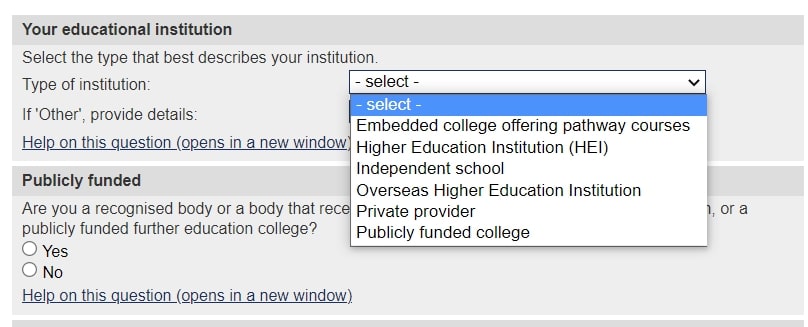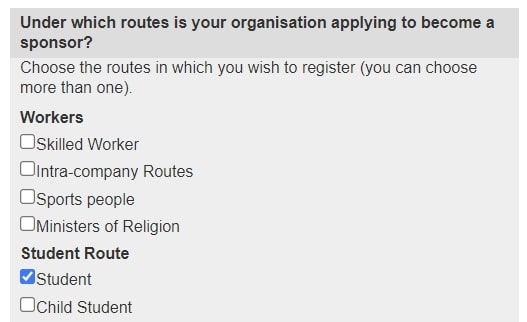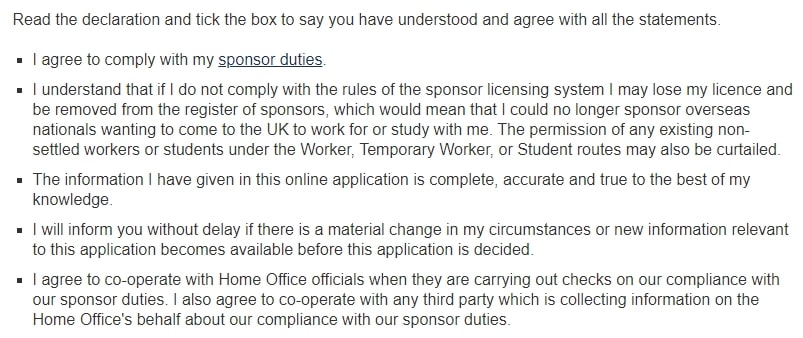- BY Nichola Carter

Briefing: how to apply for a student sponsor licence
THANKS FOR READING
Older content is locked

A great deal of time and effort goes into producing the information on Free Movement, become a member of Free Movement to get unlimited access to all articles, and much, much more
TAKE FREE MOVEMENT FURTHER
By becoming a member of Free Movement, you not only support the hard-work that goes into maintaining the website, but get access to premium features;
- Single login for personal use
- FREE downloads of Free Movement ebooks
- Access to all Free Movement blog content
- Access to all our online training materials
- Access to our busy forums
- Downloadable CPD certificates
Page contents
International students are worth billions to the UK economy in higher education fees and indirect expenditure, benefitting local communities financially as well as enriching them in non-economic terms.
Being able to attract overseas students is crucial to the economic viability of many education providers, but only those with a sponsor licence are able to enrol international students for more than six months.
Since Brexit, the stakes are even higher since EU students now have to be sponsored in the same way as non-EU students. This is unless they have pre-settled or settled status under the EU Settlement Scheme, or are otherwise lawfully entitled to study in the UK.
Here I’ll explain how an education provider can apply for a sponsor licence. When I refer to “international students”, this includes EU and non-EU students.
Do you need a licence?
The first question the education provider needs to consider is: do they actually need a sponsor licence?
A sponsor licence is not needed if the sponsor will only be teaching international students who will enrol on courses in the UK for up to six months. Providing they meet the requirements, they can come in under the visitor route.
For students to be able to study as visitors, the education provider will need to meet the Home Office’s definition of “accredited”. Having a full sponsor licence is one way to be accredited, but not the only way. A good explanation of what else counts, along with more detail about what study visitors can do, is contained in the visit visa guidance.
International students can also study English language for up to 11 months without needing to be sponsored. The short-term study visa is the relevant route.
Are you eligible?
Next question: is your institution eligible? Whilst various types of education providers are eligible for a sponsor licence (not just universities), when it comes to school-age students only independent schools can become a licensed sponsor. State schools and academies, for example, are not able to sponsor international students.

Relevant Home Office guidance
If it looks like a sponsor licence is the right way forward, the next step is to dive into the detail. And there is a lot of it…
The student sponsor guidance is a lengthy document in four parts:
- Applying for a Student sponsor licence
- Sponsorship duties
- Student sponsor compliance
- Specific information for higher education providers
Document 1 — Applying for a Student sponsor licence — contains the next bit of key information an education provider thinking of applying for a sponsor licence needs to consider: do they meet the educational oversight requirements?
Educational oversight
The Home Office’s position is that an education provider cannot apply for a licence to sponsor international students unless its academic provision, student support and other functions have been deemed acceptable by an independent body. This is known as the educational oversight requirement.
Full information is contained in document 1 but the basic point is that a higher education provider must be on the Office for Students register. Getting onto the OfS register is a detailed and generally lengthy process that higher education providers must go through before they can apply for a sponsor licence.
Independent schools must have been inspected by Ofsted or the Independent Schools Inspectorate, and private colleges must be inspected by Private Further Education. For higher education institutions based overseas but with a branch here, the relevant body is the Quality Assurance Agency for Higher Education.
The above applies to providers in England; there are similar arrangements for providers in Wales, Scotland and Northern Ireland. The online application form gives a choice of nine possible oversight bodies, of which one must be selected to progress the application, unless one of a limited range of exemptions can be invoked.
Student or Child Student licence?

Only independent schools can be granted a licence to sponsor students under the Child Student route. This is for children aged 4-18.
All other education providers can only sponsor students under the main Student route. They can’t sponsor under-18s.
The Home Office will also only allow students to be sponsored if the specific course they will be studying meets its requirements. This is set out in document 2 of the student sponsor guidance. It warns that “We will take compliance action against you if you [sponsor] a Student to take courses that do not meet our minimum level”.
Is the organisation trustworthy?
Trust is central to the sponsorship system. The guidance states that sponsors must “play their part” in ensuring that the system is not abused.
In every sponsor licence suspension or revocation letter I have ever seen, the Home Office has alleged that the organisation is no longer considered trustworthy enough to be a sponsor.
An organisation applying for a student sponsor licence can expect the Home Office to scrutinise the application, both in terms of the initial documentation filed with the application, and also during a pre-licence compliance visit (we look at these later) to ensure that the sponsor is trustworthy. The guiding principles it will rely on when doing this are contained in document 1 of the sponsor guidance.
To be issued a Student sponsor licence, an education provider must be:
- a genuine education provider that has acceptable educational quality standards, and is operating lawfully in the UK, complying with all appropriate rules and regulations;
- considered eligible and suitable to hold a sponsor licence; and
- capable of carrying out its duties as a sponsor.
The Home Office’s position is that sponsorship has been abused in the past, whether by so-called “bogus colleges”, by people who are not genuine students or even by unscrupulous gangs using the Child route in particular to traffic children to the UK.
There have been numerous court cases in which sponsors have sought to defend themselves against licence revocation, but the courts have generally found in favour of the Home Office. In the most high profile case heard at the Supreme Court, R (New London College Limited) v Secretary of State for the Home Department [2013] UKSC 51, it was made very clear to education providers that if they wanted to keep the benefits of a sponsor licence, they had to adhere to the Home Office’s rules and regulations.
Key personnel
Once the prospective sponsor is satisfied that it needs a licence, meets the educational oversight provisions and offers suitable courses, the next step is to decide who within the organisation will be responsible for the licence.
For a small sponsor, this may only be one person. Some large universities may have ten, 20 or more people who can operate the licence.
The key roles are:
- Authorising Officer – this is the person who will have overall responsibility for the licence, so they need to be senior within the organisation. The Home Office says they should be the most senior person responsible for student recruitment. I would caveat this by saying that they should be the most senior person responsible for student recruitment who will be passionate about ensuring the sponsor duties are complied with and the licence is retained. Too often I meet an Authorising Officer, usually when I’ve been called in to help tackle an allegation of non-compliance, to find they have no idea about the sponsor duties and think a call to someone senior in the Home Office will sort it all out. The Authorising Officer cannot be a legal representative.
- Key Contact – this is the person who will be the main point of contact with the Home Office about both the application and then the licence generally. A legal representative can perform this role.
- Level 1 User(s) – these people will have responsibility for the day-to-day management of the licence and the process of sponsoring students via the sponsorship management system (SMS), an online portal (desperately in need of an update which the Home Office says is in the pipeline). When the licence application is filed, there is only space for one Level 1 User but once the application is granted, more can be appointed including legal reps.
- Level 2 User(s) – can also be set up, but this role only allows very limited tasks to be performed on the SMS. I would generally not advise using this function unless the sponsor is a very large university, for example, and level 2 users will be responsible for very specific cohorts of students.
Full details on the key personnel roles are in document 1 of the sponsor guidance. If a person has a relevant unspent criminal conviction — listed at the end of document 1 of the sponsor guidance — the licence application is unlikely to be approved.
Application process
The next step is to complete an online application form accessed here. It can be quite clunky and can take a couple of attempts to log in [can confirm — Ed.] Again, the Home Office is promising a revamp.
Once you’ve managed to register, though, the application form itself is quite straightforward. It asks for confirmation of the issues covered above — eligibility, educational oversight, key personnel — plus a few other bits and pieces such as the number of students expected to need sponsorship under the licence. There is also a declaration about compliance with sponsorship duties, and various other matters.

Once the form is completed it is submitted online and the fee of £536 is paid. A PDF document called a submission sheet is then generated. This must be submitted to the Home Office within five working days along with the mandatory documents.
Supporting documents
The Home Office sets out the mandatory documents that are needed to support an application in Appendix A to the sponsor guidance:
- proof that you are based in the UK
- proof that you are operating and trading lawfully in the UK
- proof that you have registered for VAT with HM Revenue and Customs where required to do so
- a written record of a fire risk assessment conducted by a competent person
- evidence to show that you have appropriate planning permission or local planning authority consent to operate the relevant type or class of organisation at your trading address
- any documentation which is required to demonstrate that your sites, exceptional arrangements and/or partnerships, where applicable, meet all of the relevant requirements of the ‘Sites and teaching partnerships’ section of Document 1 of the Student sponsor guidance.
Whilst these look fairly simple, sponsors can expect the Home Office to quickly request more evidence than this bare minimum. This typically ranges from a request for more detail about premises (they will want to ensure premises can be lawfully used for teaching purposes and are safe), to information on child safeguarding, a detailed recruitment plan and information on the courses that are to be offered to international students — right down to the timetabling of classes.
We were once approached by an independent school that had submitted its own sponsor licence application. The fire risk assessment contained a number of action points — some critical and some less so. The school’s principal refused to accept that the actions were necessary. The Home Office refused to grant the licence until they were all resolved. Eventually the principal reluctantly accepted my advice that the much-needed licence just wasn’t going to be approved until the last action point — putting up a sign to show an emergency exit — was done and signed off. The whole saga, which could have been completed in a week or so, extended the application process by months.
The visit
A student sponsor licence application will almost certainly trigger a visit by a Home Office. At this point, it becomes really important that the organisation is able to demonstrate that it deserves to be a sponsor.
The visiting officer will want to interview those who will be responsible for compliance to check how the organisation will adhere to the rules and requirements set out in the sponsor guidance.
Preparation is key — ensure that systems are in place, policies are prepared and there’s a really good understanding of the specific sponsor duties, but also the spirit of sponsorship, that can be demonstrated to the officer who will prepare a written report.
The outcome
The processing time for a student sponsor licence can vary significantly. Anything from eight to 18 weeks would not be unusual in my experience, depending on how much to-ing and fro-ing there is at the documentation stage and how long it takes the Home Office to schedule a visit. Unfortunately the student sponsor licence application process doesn’t benefit from the priority processing service available to employers.
Licence granted
If all goes well, the Home Office will email the sponsor confirming the grant of the student sponsor licence for four years initially, renewable every four years from then on. The sponsor will be able to recruit international students from the date the licence is granted. The process for assigning a Confirmation of Acceptance for Studies — the evidence an international student needs to show that they have been accepted onto a course by an approved sponsor licence holder — is covered in the SMS manuals.
During the first year, the sponsor will be granted probationary status. This is defined in the sponsor guidance, but basically means that some restrictions may apply for the first 12 months. For example, students of a probationary sponsor may not undertake work placements if their course is below degree level, or commence studies before their visa has come through.
Licence refused
None of the student licence applications we’ve filed have ever been refused. But if a refusal decision is made, there’s no formal right of appeal. Getting things right first time — including by providing the Home Office with further information they request and preparing well for the visit — is crucial.
If the Home Office has simply made a mistake in its assessment — for instance, a caseworker hasn’t seen an important document — it’s probably going to be possible to persuade it to change the decision and grant the licence.
If a refusal decision is wholly unreasonable, a judicial review challenge could be mounted, but there would need to be a really strong case.
A new application can generally be submitted six months from the date of the original refusal, but the organisation will need to demonstrate that the reasons for the initial refusal no longer count. For example, if an application was refused because it hadn’t gained appropriate educational oversight, this has now been obtained.
Life as a student sponsor
The grant of the licence signals the moment the sponsor becomes subject to the sponsor duties — the Home Office’s lengthy and detailed rules and requirements for sponsors.
These are contained in document 2 of the sponsor guidance mentioned above — essential reading in my view. And I don’t just mean that it needs to be read once: I recommend that it is read at least every other month, and more frequently during peak recruitment time, by those responsible for licensing and sponsorship. Not least because the guidance can and does change from time to time.
It’s also important to read document 3. This explains the action that the Home Office will take if there are breaches of the sponsor duties — both minor and major.
It also explains the requirement for sponsors to pass an annual basic compliance assessment (BCA). Every year the sponsor must demonstrate to the Home Office, via an online form, that:
- less than 10% of students it sponsored in the previous year have had their subsequent visa application refused;
- at least 90% of those students have enrolled; and
- at least 85% of sponsored students due to complete courses in that year did so.
Failing the BCA means the licence can be revoked, although there is scope — both formally and informally — for the Home Office to exercise discretion before taking such drastic action.
I’ve helped numerous student sponsors over the years — from large universities to small independent schools — that have run into difficulties. My main message to senior management is to ensure that the right people are responsible for the student sponsor licence. There’s a lot of reading to do, reports to comply with and documents to retain. But given that the revenue from international students is often critical to the organisation, keeping the sponsor licence should be regarded as a key goal of the organisation.
